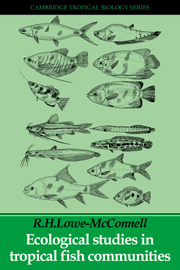Book contents
- Frontmatter
- Contents
- Preface
- Acknowledgements
- PART I INTRODUCTION
- PART II FRESHWATER STUDIES
- 2 The African fish fauna
- 3 Man-made lakes
- 4 Lacustrine fish communities in the Great Lakes of eastern Africa
- 5 Speciation: the African Great Lakes as laboratories of evolution
- 6 The Neotropical fish fauna
- 7 Far Eastern freshwater fish faunas and their distributions
- PART III MARINE FISH STUDIES
- PART IV SYNTHESES
- Appendix: Fish families in tropical waters
- References
- Index
7 - Far Eastern freshwater fish faunas and their distributions
Published online by Cambridge University Press: 07 May 2010
- Frontmatter
- Contents
- Preface
- Acknowledgements
- PART I INTRODUCTION
- PART II FRESHWATER STUDIES
- 2 The African fish fauna
- 3 Man-made lakes
- 4 Lacustrine fish communities in the Great Lakes of eastern Africa
- 5 Speciation: the African Great Lakes as laboratories of evolution
- 6 The Neotropical fish fauna
- 7 Far Eastern freshwater fish faunas and their distributions
- PART III MARINE FISH STUDIES
- PART IV SYNTHESES
- Appendix: Fish families in tropical waters
- References
- Index
Summary
Far Eastern freshwaters considered here include those of tropical Asia (Oriental Region) and of Australia/New Guinea. The Asian tropics comprise the subcontinent of India, mainland Southeast Asia, and the islands lying on the continental (Sunda) shelf, Borneo, Sumatra, Java and certain others, which were connected with the mainland at intervals when the sea level was lowered during the Pleistocene glaciations. An extinct river system flowed into the sea between the present coastlines of Borneo and the Asian mainland. The rivers of eastern Sumatra and western Borneo, and even some from India, Thailand and Indochina, were tributaries of this vast system, which accounts for many similarities in fish fauna between the islands and mainland. North Borneo rivers did not join this system, and the fauna here is somewhat impoverished. Islands lying off the Sunda shelf have completely different freshwater faunas.
Wallace's Line down the Makassa Straits between Borneo and Sulawesi (Celebes) is the world's most spectacular zoogeographical boundary affecting freshwater faunas. To the west, Borneo teems with 300+ species of primary freshwater fishes (17 families); only 140 km to the east, Sulawesi has but two primary freshwater fish species, Anabas testudineus and Channa striatus, both probably introduced by man. Sulawesi, like Borneo, does have a few secondary freshwater fishes (cyprinodonts, a synbranchid and vicarious atherinids).
- Type
- Chapter
- Information
- Ecological Studies in Tropical Fish Communities , pp. 159 - 174Publisher: Cambridge University PressPrint publication year: 1987



